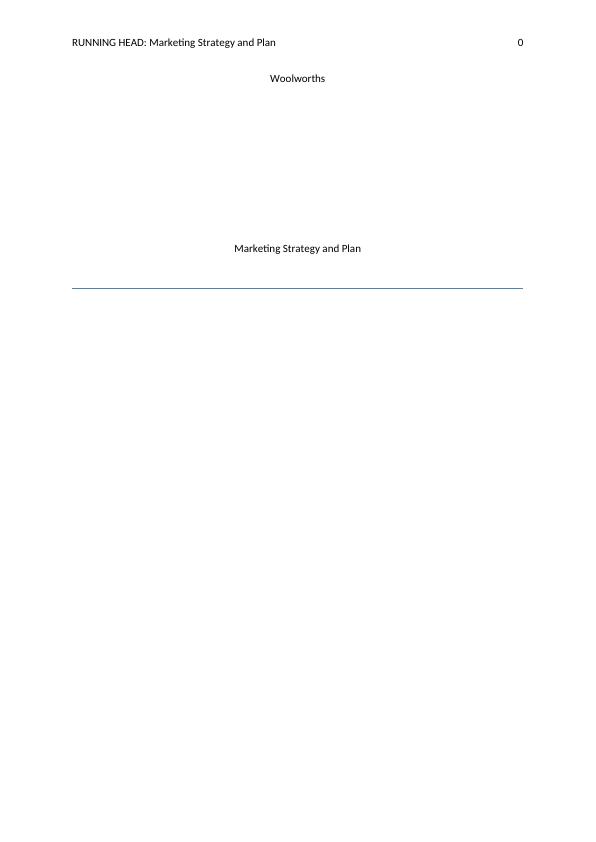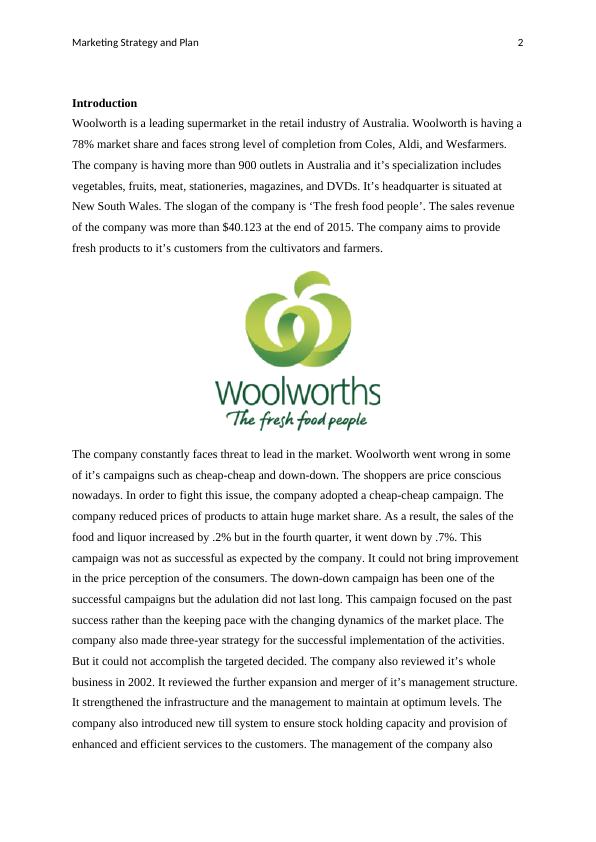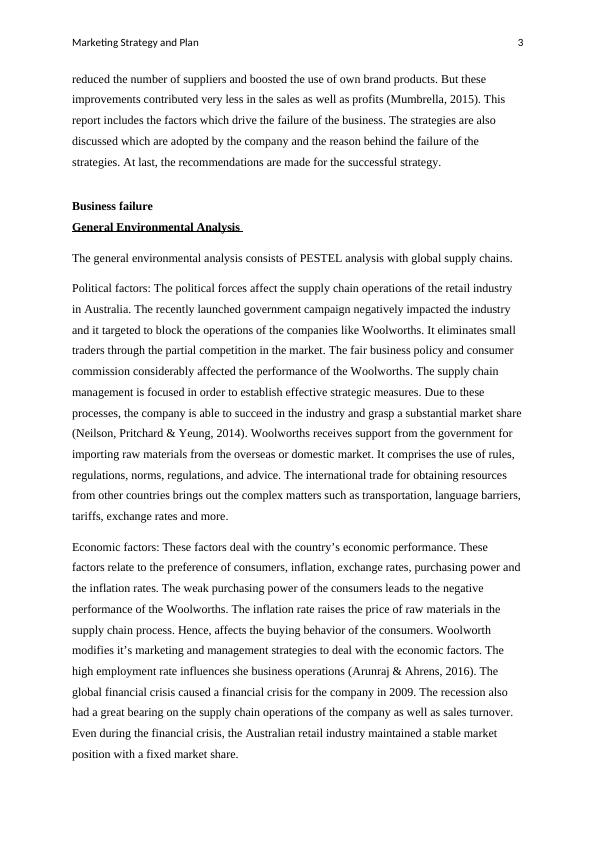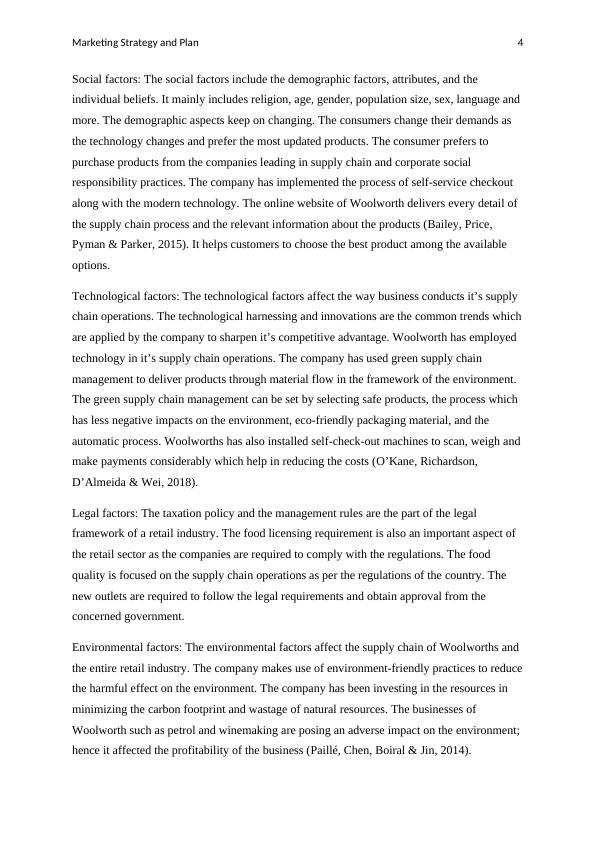Marketing Strategy and Plan for Woolworths: Factors Driving Business Failure and Unsuccessful Strategies
Added on 2023-06-08
22 Pages7697 Words417 Views
RUNNING HEAD: Marketing Strategy and Plan 0
Woolworths
Marketing Strategy and Plan
Woolworths
Marketing Strategy and Plan

Marketing Strategy and Plan 1
Contents
Introduction...........................................................................................................................................2
Business failure.....................................................................................................................................3
Unsuccessful strategies..........................................................................................................................8
Conclusion and recommendations.......................................................................................................14
References...........................................................................................................................................17
Contents
Introduction...........................................................................................................................................2
Business failure.....................................................................................................................................3
Unsuccessful strategies..........................................................................................................................8
Conclusion and recommendations.......................................................................................................14
References...........................................................................................................................................17

Marketing Strategy and Plan 2
Introduction
Woolworth is a leading supermarket in the retail industry of Australia. Woolworth is having a
78% market share and faces strong level of completion from Coles, Aldi, and Wesfarmers.
The company is having more than 900 outlets in Australia and it’s specialization includes
vegetables, fruits, meat, stationeries, magazines, and DVDs. It’s headquarter is situated at
New South Wales. The slogan of the company is ‘The fresh food people’. The sales revenue
of the company was more than $40.123 at the end of 2015. The company aims to provide
fresh products to it’s customers from the cultivators and farmers.
The company constantly faces threat to lead in the market. Woolworth went wrong in some
of it’s campaigns such as cheap-cheap and down-down. The shoppers are price conscious
nowadays. In order to fight this issue, the company adopted a cheap-cheap campaign. The
company reduced prices of products to attain huge market share. As a result, the sales of the
food and liquor increased by .2% but in the fourth quarter, it went down by .7%. This
campaign was not as successful as expected by the company. It could not bring improvement
in the price perception of the consumers. The down-down campaign has been one of the
successful campaigns but the adulation did not last long. This campaign focused on the past
success rather than the keeping pace with the changing dynamics of the market place. The
company also made three-year strategy for the successful implementation of the activities.
But it could not accomplish the targeted decided. The company also reviewed it’s whole
business in 2002. It reviewed the further expansion and merger of it’s management structure.
It strengthened the infrastructure and the management to maintain at optimum levels. The
company also introduced new till system to ensure stock holding capacity and provision of
enhanced and efficient services to the customers. The management of the company also
Introduction
Woolworth is a leading supermarket in the retail industry of Australia. Woolworth is having a
78% market share and faces strong level of completion from Coles, Aldi, and Wesfarmers.
The company is having more than 900 outlets in Australia and it’s specialization includes
vegetables, fruits, meat, stationeries, magazines, and DVDs. It’s headquarter is situated at
New South Wales. The slogan of the company is ‘The fresh food people’. The sales revenue
of the company was more than $40.123 at the end of 2015. The company aims to provide
fresh products to it’s customers from the cultivators and farmers.
The company constantly faces threat to lead in the market. Woolworth went wrong in some
of it’s campaigns such as cheap-cheap and down-down. The shoppers are price conscious
nowadays. In order to fight this issue, the company adopted a cheap-cheap campaign. The
company reduced prices of products to attain huge market share. As a result, the sales of the
food and liquor increased by .2% but in the fourth quarter, it went down by .7%. This
campaign was not as successful as expected by the company. It could not bring improvement
in the price perception of the consumers. The down-down campaign has been one of the
successful campaigns but the adulation did not last long. This campaign focused on the past
success rather than the keeping pace with the changing dynamics of the market place. The
company also made three-year strategy for the successful implementation of the activities.
But it could not accomplish the targeted decided. The company also reviewed it’s whole
business in 2002. It reviewed the further expansion and merger of it’s management structure.
It strengthened the infrastructure and the management to maintain at optimum levels. The
company also introduced new till system to ensure stock holding capacity and provision of
enhanced and efficient services to the customers. The management of the company also

Marketing Strategy and Plan 3
reduced the number of suppliers and boosted the use of own brand products. But these
improvements contributed very less in the sales as well as profits (Mumbrella, 2015). This
report includes the factors which drive the failure of the business. The strategies are also
discussed which are adopted by the company and the reason behind the failure of the
strategies. At last, the recommendations are made for the successful strategy.
Business failure
General Environmental Analysis
The general environmental analysis consists of PESTEL analysis with global supply chains.
Political factors: The political forces affect the supply chain operations of the retail industry
in Australia. The recently launched government campaign negatively impacted the industry
and it targeted to block the operations of the companies like Woolworths. It eliminates small
traders through the partial competition in the market. The fair business policy and consumer
commission considerably affected the performance of the Woolworths. The supply chain
management is focused in order to establish effective strategic measures. Due to these
processes, the company is able to succeed in the industry and grasp a substantial market share
(Neilson, Pritchard & Yeung, 2014). Woolworths receives support from the government for
importing raw materials from the overseas or domestic market. It comprises the use of rules,
regulations, norms, regulations, and advice. The international trade for obtaining resources
from other countries brings out the complex matters such as transportation, language barriers,
tariffs, exchange rates and more.
Economic factors: These factors deal with the country’s economic performance. These
factors relate to the preference of consumers, inflation, exchange rates, purchasing power and
the inflation rates. The weak purchasing power of the consumers leads to the negative
performance of the Woolworths. The inflation rate raises the price of raw materials in the
supply chain process. Hence, affects the buying behavior of the consumers. Woolworth
modifies it’s marketing and management strategies to deal with the economic factors. The
high employment rate influences she business operations (Arunraj & Ahrens, 2016). The
global financial crisis caused a financial crisis for the company in 2009. The recession also
had a great bearing on the supply chain operations of the company as well as sales turnover.
Even during the financial crisis, the Australian retail industry maintained a stable market
position with a fixed market share.
reduced the number of suppliers and boosted the use of own brand products. But these
improvements contributed very less in the sales as well as profits (Mumbrella, 2015). This
report includes the factors which drive the failure of the business. The strategies are also
discussed which are adopted by the company and the reason behind the failure of the
strategies. At last, the recommendations are made for the successful strategy.
Business failure
General Environmental Analysis
The general environmental analysis consists of PESTEL analysis with global supply chains.
Political factors: The political forces affect the supply chain operations of the retail industry
in Australia. The recently launched government campaign negatively impacted the industry
and it targeted to block the operations of the companies like Woolworths. It eliminates small
traders through the partial competition in the market. The fair business policy and consumer
commission considerably affected the performance of the Woolworths. The supply chain
management is focused in order to establish effective strategic measures. Due to these
processes, the company is able to succeed in the industry and grasp a substantial market share
(Neilson, Pritchard & Yeung, 2014). Woolworths receives support from the government for
importing raw materials from the overseas or domestic market. It comprises the use of rules,
regulations, norms, regulations, and advice. The international trade for obtaining resources
from other countries brings out the complex matters such as transportation, language barriers,
tariffs, exchange rates and more.
Economic factors: These factors deal with the country’s economic performance. These
factors relate to the preference of consumers, inflation, exchange rates, purchasing power and
the inflation rates. The weak purchasing power of the consumers leads to the negative
performance of the Woolworths. The inflation rate raises the price of raw materials in the
supply chain process. Hence, affects the buying behavior of the consumers. Woolworth
modifies it’s marketing and management strategies to deal with the economic factors. The
high employment rate influences she business operations (Arunraj & Ahrens, 2016). The
global financial crisis caused a financial crisis for the company in 2009. The recession also
had a great bearing on the supply chain operations of the company as well as sales turnover.
Even during the financial crisis, the Australian retail industry maintained a stable market
position with a fixed market share.

Marketing Strategy and Plan 4
Social factors: The social factors include the demographic factors, attributes, and the
individual beliefs. It mainly includes religion, age, gender, population size, sex, language and
more. The demographic aspects keep on changing. The consumers change their demands as
the technology changes and prefer the most updated products. The consumer prefers to
purchase products from the companies leading in supply chain and corporate social
responsibility practices. The company has implemented the process of self-service checkout
along with the modern technology. The online website of Woolworth delivers every detail of
the supply chain process and the relevant information about the products (Bailey, Price,
Pyman & Parker, 2015). It helps customers to choose the best product among the available
options.
Technological factors: The technological factors affect the way business conducts it’s supply
chain operations. The technological harnessing and innovations are the common trends which
are applied by the company to sharpen it’s competitive advantage. Woolworth has employed
technology in it’s supply chain operations. The company has used green supply chain
management to deliver products through material flow in the framework of the environment.
The green supply chain management can be set by selecting safe products, the process which
has less negative impacts on the environment, eco-friendly packaging material, and the
automatic process. Woolworths has also installed self-check-out machines to scan, weigh and
make payments considerably which help in reducing the costs (O’Kane, Richardson,
D’Almeida & Wei, 2018).
Legal factors: The taxation policy and the management rules are the part of the legal
framework of a retail industry. The food licensing requirement is also an important aspect of
the retail sector as the companies are required to comply with the regulations. The food
quality is focused on the supply chain operations as per the regulations of the country. The
new outlets are required to follow the legal requirements and obtain approval from the
concerned government.
Environmental factors: The environmental factors affect the supply chain of Woolworths and
the entire retail industry. The company makes use of environment-friendly practices to reduce
the harmful effect on the environment. The company has been investing in the resources in
minimizing the carbon footprint and wastage of natural resources. The businesses of
Woolworth such as petrol and winemaking are posing an adverse impact on the environment;
hence it affected the profitability of the business (Paillé, Chen, Boiral & Jin, 2014).
Social factors: The social factors include the demographic factors, attributes, and the
individual beliefs. It mainly includes religion, age, gender, population size, sex, language and
more. The demographic aspects keep on changing. The consumers change their demands as
the technology changes and prefer the most updated products. The consumer prefers to
purchase products from the companies leading in supply chain and corporate social
responsibility practices. The company has implemented the process of self-service checkout
along with the modern technology. The online website of Woolworth delivers every detail of
the supply chain process and the relevant information about the products (Bailey, Price,
Pyman & Parker, 2015). It helps customers to choose the best product among the available
options.
Technological factors: The technological factors affect the way business conducts it’s supply
chain operations. The technological harnessing and innovations are the common trends which
are applied by the company to sharpen it’s competitive advantage. Woolworth has employed
technology in it’s supply chain operations. The company has used green supply chain
management to deliver products through material flow in the framework of the environment.
The green supply chain management can be set by selecting safe products, the process which
has less negative impacts on the environment, eco-friendly packaging material, and the
automatic process. Woolworths has also installed self-check-out machines to scan, weigh and
make payments considerably which help in reducing the costs (O’Kane, Richardson,
D’Almeida & Wei, 2018).
Legal factors: The taxation policy and the management rules are the part of the legal
framework of a retail industry. The food licensing requirement is also an important aspect of
the retail sector as the companies are required to comply with the regulations. The food
quality is focused on the supply chain operations as per the regulations of the country. The
new outlets are required to follow the legal requirements and obtain approval from the
concerned government.
Environmental factors: The environmental factors affect the supply chain of Woolworths and
the entire retail industry. The company makes use of environment-friendly practices to reduce
the harmful effect on the environment. The company has been investing in the resources in
minimizing the carbon footprint and wastage of natural resources. The businesses of
Woolworth such as petrol and winemaking are posing an adverse impact on the environment;
hence it affected the profitability of the business (Paillé, Chen, Boiral & Jin, 2014).

Marketing Strategy and Plan 5
However, the company supports the recycling practices for a improved environment. The
company makes use of the practices which are ethically sound.
The Industry Environment
The industry environment can be analyzed by Porter’s five forces framework. It evaluates the
present position of the retail industry and the means in which the factors affect the
performance. The analysis of the retail industry can be done through the following tools:
Bargaining power of buyers: The bargaining power of buyers is considerably higher in
relation to the retail industry of Australia. There are various supermarkets and retail stores in
the Australia which provides a different kind of items to the customers. There is a low
switching cost between stores as the supermarkets offer homogenous products. The
bargaining power of the customers is comparatively high due to the availability of wider
options of supermarkets (Pantano, Priporas, Sorace, & Iazzolino, 2017).
Bargaining power of suppliers: The bargaining power of suppliers in the retail industry is
moderate. It depends on the brand name of the suppliers and the extent of the supermarket.
There are certain players in the retail industry of Australia that have a major market share.
This factor upturns the bargaining power of suppliers up to a definite level (The New Daily,
2018). The suppliers have more power when the supply reduces due to climate changes.
Woolworth has opted a significant supply chain management to satisfy customers.
The threat of new entry: The threat of entry in the retail industry of Australia is low. The
established firms have made it problematic for the new players to move into the industry. The
retail industry offers low-profit margin so it is not successful in attracting industries to take
the entry (Mortimer & Ingersoll, 2015). The huge capital investment, government
regulations, high price of land creates barriers to entry in the retail industry. The larger retail
companies have dominated the Australian market. For instance, Aldi has affected the
profitability of Woolworths and has made the rivalry higher.
Rivalry among existing firms: The rivalry among the existing firms is higher as there are few
major competitors such as Wesfarmers, Coles supermarket, Asda, IGA and more. These
competitors compete against each other to attain the largest market share. Such competition
has reduced the profitability of Woolworths. There are chances of increasing sales in the
future (Sutton-Brady, Kamvounias & Taylor, 2015).
However, the company supports the recycling practices for a improved environment. The
company makes use of the practices which are ethically sound.
The Industry Environment
The industry environment can be analyzed by Porter’s five forces framework. It evaluates the
present position of the retail industry and the means in which the factors affect the
performance. The analysis of the retail industry can be done through the following tools:
Bargaining power of buyers: The bargaining power of buyers is considerably higher in
relation to the retail industry of Australia. There are various supermarkets and retail stores in
the Australia which provides a different kind of items to the customers. There is a low
switching cost between stores as the supermarkets offer homogenous products. The
bargaining power of the customers is comparatively high due to the availability of wider
options of supermarkets (Pantano, Priporas, Sorace, & Iazzolino, 2017).
Bargaining power of suppliers: The bargaining power of suppliers in the retail industry is
moderate. It depends on the brand name of the suppliers and the extent of the supermarket.
There are certain players in the retail industry of Australia that have a major market share.
This factor upturns the bargaining power of suppliers up to a definite level (The New Daily,
2018). The suppliers have more power when the supply reduces due to climate changes.
Woolworth has opted a significant supply chain management to satisfy customers.
The threat of new entry: The threat of entry in the retail industry of Australia is low. The
established firms have made it problematic for the new players to move into the industry. The
retail industry offers low-profit margin so it is not successful in attracting industries to take
the entry (Mortimer & Ingersoll, 2015). The huge capital investment, government
regulations, high price of land creates barriers to entry in the retail industry. The larger retail
companies have dominated the Australian market. For instance, Aldi has affected the
profitability of Woolworths and has made the rivalry higher.
Rivalry among existing firms: The rivalry among the existing firms is higher as there are few
major competitors such as Wesfarmers, Coles supermarket, Asda, IGA and more. These
competitors compete against each other to attain the largest market share. Such competition
has reduced the profitability of Woolworths. There are chances of increasing sales in the
future (Sutton-Brady, Kamvounias & Taylor, 2015).

End of preview
Want to access all the pages? Upload your documents or become a member.
Related Documents
HI6006 - Competitive Strategylg...
|6
|1345
|105
Information System Management and Strategy of Woolworthlg...
|9
|1933
|585
Marketing Mix and Strategies of Woolworthslg...
|13
|4420
|296
Non-price Based Marketing Strategylg...
|8
|2431
|298
Organization Strategy and Business Model of Woolworths Limitedlg...
|11
|3038
|22
Marketing Mix Strategies of Woolworthslg...
|16
|4149
|322
